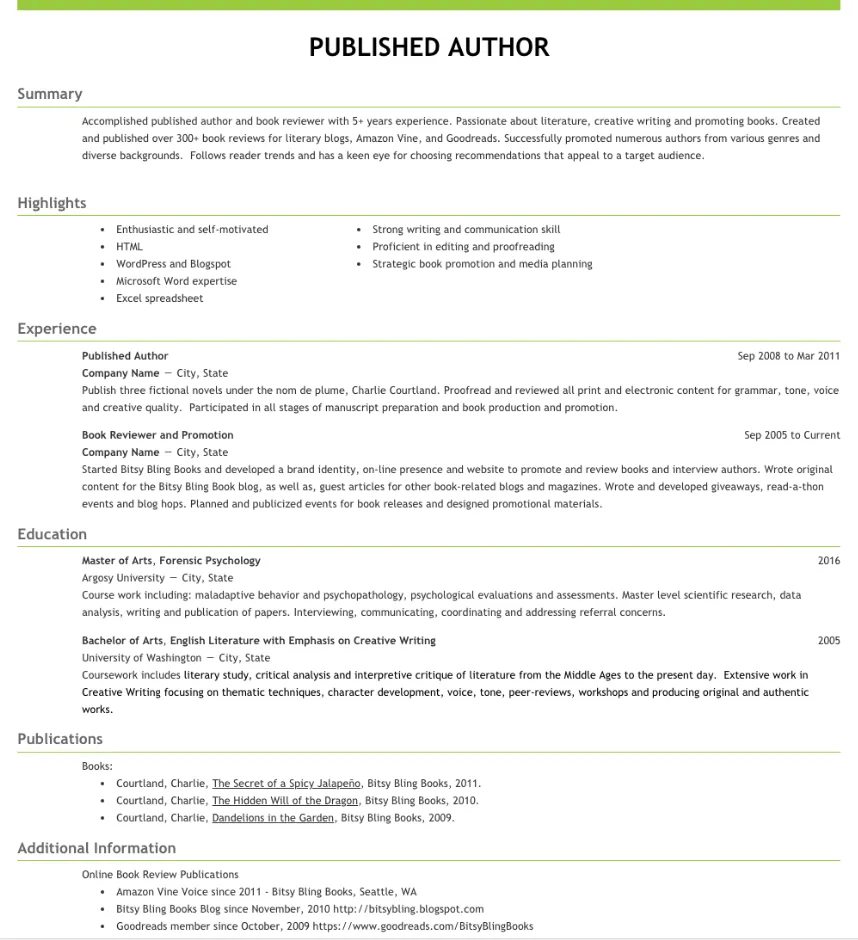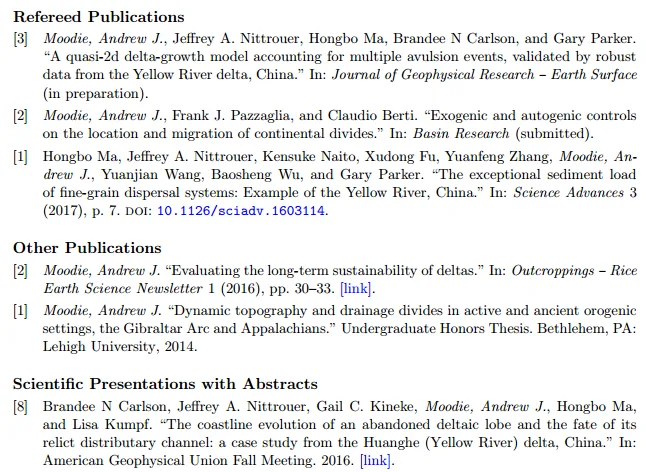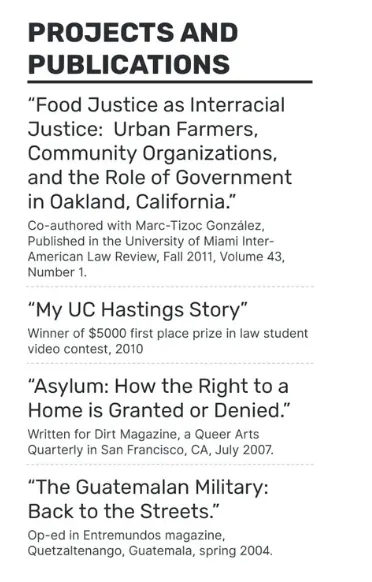Having publications on your resume is one of the best ways to demonstrate your knowledge of the industry. It’s usually an optional section, but it can add tremendous value to your job application when organized properly.
On the other hand, there are instances where publications are a must-have. For example, if you’re making a CV for an academic position, a strong list of publications can make or break your application.
That’s why we’ve created this practical guide to help you learn how to list publications on your resume and where to put them to get noticed.
Without further ado, let’s jump in!
Key Takeaways
Publications are important because they show recruiters your actual work and further highlight your competence in the field.
There are two different types of publications you can add to your resume—academic and non-academic ones.
Resumes usually feature non-academic publications. The section is optional, and it should only include relevant publications.
CVs mostly feature academic publications, and this section is a must-have. It can be more than one page long and should follow a strict citation style (e.g., APA, MLA, etc.).
Different Publication Types You Can List on a Resume and CV

Everything from academic articles, books, and theses to conference papers or newspaper articles can fit in the publications section on your resume. Broadly speaking, there are two different publication categories:
Types of Publications
Academic publications
Non-academic publications
Academic Publication Types
Academic publications refer to work written by industry professionals. These often take a long time to publish and utilize a specific sort of peer review to ensure quality. Also, academic writing uses formal language and is highly specific, which is why it’s perfect for CVs.
Some of the publications that belong to this type are:
Academic Publications
Published research papers. This refers to the written work that is usually published in academic journals. As the name suggests, the focus is on research or a review of some kind of research.
Research papers pending to be published. This includes any finished work you plan on submitting or the one you already submitted and it’s now waiting for a review.
Academic books. These lengthy publications often feature tens of thousands of words. They used to be printed but now come in the form of e-books, digital critical editions, archives, and more.
Academic articles. Academic articles are shorter than books or research papers but are on the same quality level.
Conference papers. These are the shortest, most concise publications on the list, usually submitted and presented at conferences.
Non-Academic Publication Types
Non-academic publications are aimed at a wider audience. The language used is informal, and it may even contain slang. There’s no need to provide a list of references or to have any credentials for non-academic publications, which makes it more suited for resumes.
Some of these publications are:
Non-Academic Publications
Publications in industry journals. While not on the same level as academic articles, these publications are valued by professionals in the field.
Books or chapters. These are the non-academic counterparts to academic books. They belong to lengthy publications and can be an extremely important element of your resume.
Newspapers articles. These publications include any articles written for newspapers that are relevant to the job you’re applying for.
Website articles. Even though these belong to one of the most casual forms of publications on a resume, they are still valuable in certain instances.
Why Are Publications on a Resume Important?
Publications on a resume give recruiters the option to see your authentic work and allow you to further highlight your knowledge in a specific industry. You also get to show off something more substantial than a simple list of skills or degrees since writing a publication requires extraordinary experience in the field.
Academic publications are generally much more important and valuable than non-academic ones. They always take precedence and should be added to your resume first.
Furthermore, if you’re applying for any kind of scientific role, a role in academia, or a position that requires research, these are mandatory. That’s when it becomes all the more important to know precisely how to list research publications on a resume to make them stand out.
What is the Difference Between Listing Publications on a Resume vs. on a CV?

Many people use the terms “resume” and “CV” interchangeably. And while these terms really mean the same thing in some parts of the world, in the US, for example, there are stark differences between the two.
A resume is a document people use to apply for jobs. In such cases, publications can be helpful but are not required. The “rules” are also more lenient, meaning you can include a lot more non-academic publications without sticking to a particular format.
A CV is an academic-oriented application, and as such, it puts a lot more emphasis on publications than a resume. Most of your publications on a CV should be academic and created with a major citation style (e.g., APA or MLA) in mind. Also, CVs can be longer than resumes, so there’s room to include all publications that showcase your expertise.
How to Add Publications to a Resume
Let’s take a look at four crucial guidelines that will help you create an impeccable publications section on your resume.
#1. Select Which Publications to Add
Relevance is the name of the game in resume-building. Every piece of information—publications included—needs to tell recruiters that you’re the right person for the job. That’s why you want to focus only on those that highlight your career-specific experience and knowledge.
For example, if you’re applying for a position in the IT field, there’s no need to learn how to list poetry publications on your resume, as the career you choose has nothing to do with these. If you don’t have a relevant publication to add, it’s better to use that valuable space to include more relevant information in some other section.
#2. Pick a Spot to List Publications
Publications are an optional section on your resume, and, as such, they shouldn’t be its main focus. Since they are usually tightly connected to your education, you should list them under it in a separate section.
However, if you only have one publication to list, it probably doesn’t warrant a whole section. In that case, you can add it to your education history. The same applies if you have fewer publications that aren’t peer-reviewed and you need space for more important information to include in other sections of your resume.
#3. Choose a Citation Style
Two of the most widely used citation styles for resumes are:
APA style is the most popular citation style. It’s used in the social sciences and engineering fields. It features the following format:
[Last name], [Initial]. ([Year]). [Article title]. [Journal name], [Volume number] ([Issue number]) [Pages]. [URL/DOI]
Here’s what that format looks like:

MLA is the second most popular style and is frequently used in the humanities fields. It goes as follows:
[Last name], [First name]. “[Article title].” [Journal name], [Volume number], [Issue number], [Year], [Pages], [URL/DOI].
Now let’s see that format in action:

Of course, the rules are less rigid when you’re listing non-academic publications, which is often the case on resumes. It’s perfectly fine to omit some information if you don’t have it (such as “journal name," “volume number," and similar).
#4. Go For the Right Format
The final piece of the puzzle in creating an engaging publications section on your resume is selecting the appropriate format. Everything from font style and size to line and paragraph spacing needs to be the same as in the rest of your document.
Consistent formatting is key to making the whole application presentable and professional. It increases readability, which is especially important when you include more complex publications. It also helps you pass the ATS scan, as it makes the section and its keywords clearly visible.
Now that we’ve outlined all the general guidelines, let’s take a look at a resume of a published author and their non-academic publications:

How to Add Publications to a CV

Compared to resumes, academic CV publications are a whole new endeavor. Since the purpose of a CV is to help you apply for a position in an academic environment, there will be much more emphasis on your publications.
CVs are often longer than resumes, too. While a resume should be one page long in most cases, CVs can span multiple pages, with your publications section taking up a whole page or longer. So, if you’re wondering how to list scientific publications on your resume, you probably need a CV.
In such cases, focus on the academic, peer-reviewed, and qualified written work that will best show your knowledge. Add your academic books, articles, papers, and other publications to your CV to create a captivating list worthy of an academic professional. Finally, decide on a citation style and study it thoroughly since every detail is important.
Let’s take a look at an extensive CV publications section:

How to List Non-Academic Publications
In general, there are far fewer rules when it comes to listing non-academic publications on your resume. The hiring managers are much more tolerant when it comes to these—for example, they likely won’t pay as much attention to your citation style.
Still, your goal is to make the section clean and legible and include all the necessary information. Your best bet is to use one of the citation styles as inspiration and follow it until you create a pattern that suits your application. It won’t be possible to replicate it completely if, for instance, you’re listing a blog post, but you’ll still end up with a professional-looking section.
Whether you’re listing articles on websites or magazines, books, chapters, newspaper articles, or more, use one style and format all the way through.
Another thing to keep in mind is the amount of space on your document. You won’t have several pages to list all your publications. Plus, they are less important than academic ones, so you want to focus only on those that are relevant to the job you’re applying for.
Let’s take a look at a creative and informal way to list non-academic publications on your resume:

9 Tips to List Publications on a Resume Professionally
Here are 9 bonus tips to help you ace the publications section on a resume:
Tips for Listing Publications on your Resume
When listing publications on your resume, use the reverse chronological format. It highlights the most recent one and gives recruiters a better insight into your publication history all the way back to your beginnings.
When listing publications on your CV, put your highest-quality work first. Focus on peer-reviewed articles and include the rest in descending order.
When studying the chosen citation style, pay attention to details to know how to format and capitalize titles or whether to use a full name or an initial. Also, focus on one style exclusively and don’t mix them throughout your resume.
When there are multiple co-authors, don’t forget to include everyone’s name, but emphasize yours by bolding or underlining it.
If the title of the article doesn’t talk about your skills, and you’re using an informal citation style, consider writing a one-phrase description instead of its title. Then include a skill or a keyword (e.g., “An Article About the Best Social Media Marketing Practices, Marketing Journal”)
If you have a few publications that are tightly connected to your education, you can list them within that section.
If you have submitted an article that hasn’t been accepted yet, mark it as “manuscript submitted for publication” and list it without the journal name.
If your article has been reviewed but hasn’t been published yet, omit the issue number and add “In press” after your name.
Don’t include outdated publications since they likely aren’t relevant anymore.
Closing Thoughts
Adding publications to your resume can be a challenging endeavor. And, well, putting together a CV for an academic position that contains a lot of publications makes things even more complicated.
That’s why we covered every aspect of the process in this article. You now know when, where, and how to add publications to your application. Moreover, you’re familiar with all the details you need to focus on to get the most out of this section.
Finally, you know all the rules and guidelines, as well as when you can break them and get creative with publications on your resume. Implement this newfound knowledge, and your dream job will be right around the corner! Best of luck!


